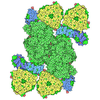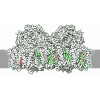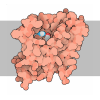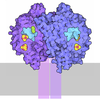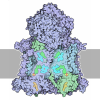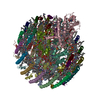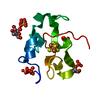[English] 日本語
 Yorodumi
Yorodumi- PDB-8z82: Photosynthetic LH1-RC-HiPIP complex from the purple bacterium Hal... -
+ Open data
Open data
- Basic information
Basic information
| Entry | Database: PDB / ID: 8z82 | |||||||||||||||||||||||||||||||||||||||||||||
|---|---|---|---|---|---|---|---|---|---|---|---|---|---|---|---|---|---|---|---|---|---|---|---|---|---|---|---|---|---|---|---|---|---|---|---|---|---|---|---|---|---|---|---|---|---|---|
| Title | Photosynthetic LH1-RC-HiPIP complex from the purple bacterium Halorhodospira halophila | |||||||||||||||||||||||||||||||||||||||||||||
 Components Components |
| |||||||||||||||||||||||||||||||||||||||||||||
 Keywords Keywords | PHOTOSYNTHESIS / LH1-RC | |||||||||||||||||||||||||||||||||||||||||||||
| Function / homology |  Function and homology information Function and homology informationorganelle inner membrane / aerobic electron transport chain / plasma membrane-derived chromatophore membrane / plasma membrane light-harvesting complex / bacteriochlorophyll binding / photosynthetic electron transport in photosystem II / photosynthesis, light reaction / endomembrane system / 4 iron, 4 sulfur cluster binding / electron transfer activity ...organelle inner membrane / aerobic electron transport chain / plasma membrane-derived chromatophore membrane / plasma membrane light-harvesting complex / bacteriochlorophyll binding / photosynthetic electron transport in photosystem II / photosynthesis, light reaction / endomembrane system / 4 iron, 4 sulfur cluster binding / electron transfer activity / iron ion binding / heme binding / metal ion binding / membrane / plasma membrane Similarity search - Function | |||||||||||||||||||||||||||||||||||||||||||||
| Biological species |  Halorhodospira halophila (bacteria) Halorhodospira halophila (bacteria) | |||||||||||||||||||||||||||||||||||||||||||||
| Method | ELECTRON MICROSCOPY / single particle reconstruction / cryo EM / Resolution: 2.4 Å | |||||||||||||||||||||||||||||||||||||||||||||
 Authors Authors | Tani, K. / Kanno, R. / Nagashima, K.V.P. / Hiwatashi, N. / Kawakami, M. / Nakata, K. / Nagashima, S. / Inoue, K. / Takaichi, S. / Purba, E.R. ...Tani, K. / Kanno, R. / Nagashima, K.V.P. / Hiwatashi, N. / Kawakami, M. / Nakata, K. / Nagashima, S. / Inoue, K. / Takaichi, S. / Purba, E.R. / Hall, M. / Yu, L.-J. / Madigan, M.T. / Mizoguchi, A. / Humbel, B.M. / Kimura, Y. / Wang-Otomo, Z.-Y. | |||||||||||||||||||||||||||||||||||||||||||||
| Funding support |  Japan, 6items Japan, 6items
| |||||||||||||||||||||||||||||||||||||||||||||
 Citation Citation |  Journal: Commun Biol / Year: 2025 Journal: Commun Biol / Year: 2025Title: A Native LH1-RC-HiPIP Supercomplex from an Extremophilic Phototroph. Authors: Kazutoshi Tani / Ryo Kanno / Kenji V P Nagashima / Mai Kawakami / Naho Hiwatashi / Kazuna Nakata / Sakiko Nagashima / Kazuhito Inoue / Shinichi Takaichi / Endang R Purba / Malgorzata Hall / ...Authors: Kazutoshi Tani / Ryo Kanno / Kenji V P Nagashima / Mai Kawakami / Naho Hiwatashi / Kazuna Nakata / Sakiko Nagashima / Kazuhito Inoue / Shinichi Takaichi / Endang R Purba / Malgorzata Hall / Long-Jiang Yu / Michael T Madigan / Akira Mizoguchi / Bruno M Humbel / Yukihiro Kimura / Zheng-Yu Wang-Otomo /    Abstract: Halorhodospira (Hlr.) halophila strain BN9622 is an extremely halophilic and alkaliphilic purple phototrophic bacterium and has been widely used as a model for exploring the osmoadaptive and ...Halorhodospira (Hlr.) halophila strain BN9622 is an extremely halophilic and alkaliphilic purple phototrophic bacterium and has been widely used as a model for exploring the osmoadaptive and photosynthetic strategies employed by phototrophic extreme halophiles that enable them to thrive in hypersaline environments. Here we present the cryo-EM structures of (1) a unique native Hlr. halophila triple-complex formed from light-harvesting (LH1), the reaction center (RC), and high-potential iron-sulfur protein (HiPIP) at 2.44 Å resolution, and (2) a HiPIP-free LH1-RC complex at 2.64 Å resolution. Differing from the LH1 in the Hlr. halophila LH1-LH2 co-complex where LH1 encircles LH2, the RC-associated LH1 complex consists of 16 (rather than 18) αβ-subunits circularly surrounding the RC. These distinct forms of LH1 indicate that the number of subunits in a Hlr. halophila LH1 complex is flexible and its size is a function of the photocomplex it encircles. Like LH1 in the LH1-LH2 co-complex, the RC-associated LH1 complex also contained two forms of αβ-polypeptides and both dimeric and monomeric molecules of bacteriochlorophyll a. The majority of the isolated Hlr. halophila LH1-RC complexes contained the electron donor HiPIP bound to the surface of the RC cytochrome subunit near the heme-1 group. The bound HiPIP consisted of an N-terminal functional domain and a long C-terminal extension firmly attached to the cytochrome subunit. Despite overall highly negative surface-charge distributions for both the cytochrome subunit and HiPIP, the interface between the two proteins was relatively uncharged and neutral, forming a pathway for electron tunneling. The structure of the Hlr. halophila LH1-RC-HiPIP complex provides insights into the mechanism of light energy acquisition coupled with a long-distance electron donating process toward the charge separation site in a multi-extremophilic phototroph. | |||||||||||||||||||||||||||||||||||||||||||||
| History |
|
- Structure visualization
Structure visualization
| Structure viewer | Molecule:  Molmil Molmil Jmol/JSmol Jmol/JSmol |
|---|
- Downloads & links
Downloads & links
- Download
Download
| PDBx/mmCIF format |  8z82.cif.gz 8z82.cif.gz | 742.4 KB | Display |  PDBx/mmCIF format PDBx/mmCIF format |
|---|---|---|---|---|
| PDB format |  pdb8z82.ent.gz pdb8z82.ent.gz | 627.1 KB | Display |  PDB format PDB format |
| PDBx/mmJSON format |  8z82.json.gz 8z82.json.gz | Tree view |  PDBx/mmJSON format PDBx/mmJSON format | |
| Others |  Other downloads Other downloads |
-Validation report
| Summary document |  8z82_validation.pdf.gz 8z82_validation.pdf.gz | 7.3 MB | Display |  wwPDB validaton report wwPDB validaton report |
|---|---|---|---|---|
| Full document |  8z82_full_validation.pdf.gz 8z82_full_validation.pdf.gz | 7.6 MB | Display | |
| Data in XML |  8z82_validation.xml.gz 8z82_validation.xml.gz | 174.2 KB | Display | |
| Data in CIF |  8z82_validation.cif.gz 8z82_validation.cif.gz | 212.8 KB | Display | |
| Arichive directory |  https://data.pdbj.org/pub/pdb/validation_reports/z8/8z82 https://data.pdbj.org/pub/pdb/validation_reports/z8/8z82 ftp://data.pdbj.org/pub/pdb/validation_reports/z8/8z82 ftp://data.pdbj.org/pub/pdb/validation_reports/z8/8z82 | HTTPS FTP |
-Related structure data
| Related structure data |  39836MC 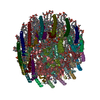 8z83C M: map data used to model this data C: citing same article ( |
|---|---|
| Similar structure data | Similarity search - Function & homology  F&H Search F&H Search |
- Links
Links
- Assembly
Assembly
| Deposited unit | 
|
|---|---|
| 1 |
|
- Components
Components
-Photosynthetic reaction ... , 2 types, 2 molecules CH
| #1: Protein | Mass: 40439.383 Da / Num. of mol.: 1 / Source method: isolated from a natural source / Source: (natural)  Halorhodospira halophila (bacteria) / Strain: BN9622 / References: UniProt: A1WXF5 Halorhodospira halophila (bacteria) / Strain: BN9622 / References: UniProt: A1WXF5 |
|---|---|
| #4: Protein | Mass: 30904.004 Da / Num. of mol.: 1 / Source method: isolated from a natural source / Source: (natural)  Halorhodospira halophila (bacteria) / Strain: BN9622 / References: UniProt: A1WXI3 Halorhodospira halophila (bacteria) / Strain: BN9622 / References: UniProt: A1WXI3 |
-Reaction center protein ... , 2 types, 2 molecules LM
| #2: Protein | Mass: 30718.809 Da / Num. of mol.: 1 / Source method: isolated from a natural source / Source: (natural)  Halorhodospira halophila (bacteria) / Strain: BN9622 / References: UniProt: A0A2L1K3P0 Halorhodospira halophila (bacteria) / Strain: BN9622 / References: UniProt: A0A2L1K3P0 |
|---|---|
| #3: Protein | Mass: 35925.391 Da / Num. of mol.: 1 / Source method: isolated from a natural source / Source: (natural)  Halorhodospira halophila (bacteria) / Strain: BN9622 / References: UniProt: A0A2L1K3T5 Halorhodospira halophila (bacteria) / Strain: BN9622 / References: UniProt: A0A2L1K3T5 |
-Antenna complex, alpha/beta ... , 4 types, 32 molecules AFKQUY37BGNRVZ48DIOSW159EJPTX260
| #5: Protein | Mass: 7275.500 Da / Num. of mol.: 8 / Source method: isolated from a natural source / Source: (natural)  Halorhodospira halophila (bacteria) / Strain: BN9622 / References: UniProt: A1WWW5 Halorhodospira halophila (bacteria) / Strain: BN9622 / References: UniProt: A1WWW5#6: Protein | Mass: 8068.154 Da / Num. of mol.: 8 / Source method: isolated from a natural source / Source: (natural)  Halorhodospira halophila (bacteria) / Strain: BN9622 / References: UniProt: A1WWW6 Halorhodospira halophila (bacteria) / Strain: BN9622 / References: UniProt: A1WWW6#7: Protein | Mass: 7664.882 Da / Num. of mol.: 8 / Source method: isolated from a natural source / Source: (natural)  Halorhodospira halophila (bacteria) / Strain: BN9622 / References: UniProt: A1WXF8 Halorhodospira halophila (bacteria) / Strain: BN9622 / References: UniProt: A1WXF8#8: Protein | Mass: 7893.913 Da / Num. of mol.: 8 / Source method: isolated from a natural source / Source: (natural)  Halorhodospira halophila (bacteria) / Strain: BN9622 / References: UniProt: A1WXF9 Halorhodospira halophila (bacteria) / Strain: BN9622 / References: UniProt: A1WXF9 |
|---|
-Protein / Sugars , 2 types, 14 molecules a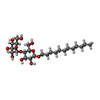

| #15: Sugar | ChemComp-LMT / #9: Protein | | Mass: 15763.442 Da / Num. of mol.: 1 / Source method: isolated from a natural source / Source: (natural)  Halorhodospira halophila (bacteria) / Strain: BN9622 / References: UniProt: A1WXH6 Halorhodospira halophila (bacteria) / Strain: BN9622 / References: UniProt: A1WXH6 |
|---|
-Non-polymers , 14 types, 125 molecules 

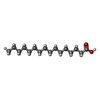
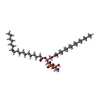
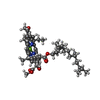
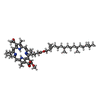


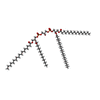


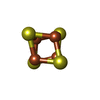













| #10: Chemical | ChemComp-HEC / #11: Chemical | ChemComp-MG / | #12: Chemical | ChemComp-LJQ / [( | Mass: 498.779 Da / Num. of mol.: 1 / Source method: obtained synthetically / Formula: C30H58O5 #13: Chemical | ChemComp-PLM / | #14: Chemical | ChemComp-PGV / ( #16: Chemical | ChemComp-BCL / #17: Chemical | #18: Chemical | #19: Chemical | ChemComp-FE / | #20: Chemical | ChemComp-CDL / #21: Chemical | ChemComp-MQ8 / | #22: Chemical | ChemComp-CRT / #23: Chemical | ChemComp-SF4 / | #24: Water | ChemComp-HOH / | |
|---|
-Details
| Has ligand of interest | Y |
|---|---|
| Has protein modification | Y |
-Experimental details
-Experiment
| Experiment | Method: ELECTRON MICROSCOPY |
|---|---|
| EM experiment | Aggregation state: PARTICLE / 3D reconstruction method: single particle reconstruction |
- Sample preparation
Sample preparation
| Component |
| ||||||||||||||||||
|---|---|---|---|---|---|---|---|---|---|---|---|---|---|---|---|---|---|---|---|
| Molecular weight |
| ||||||||||||||||||
| Source (natural) |
| ||||||||||||||||||
| Buffer solution | pH: 8 | ||||||||||||||||||
| Specimen | Conc.: 6 mg/ml / Embedding applied: NO / Shadowing applied: NO / Staining applied: NO / Vitrification applied: YES / Details: This sample was monodisperse. | ||||||||||||||||||
| Vitrification | Instrument: LEICA EM GP / Cryogen name: ETHANE / Humidity: 90 % / Chamber temperature: 277 K |
- Electron microscopy imaging
Electron microscopy imaging
| Experimental equipment |  Model: Titan Krios / Image courtesy: FEI Company |
|---|---|
| Microscopy | Model: TFS KRIOS |
| Electron gun | Electron source:  FIELD EMISSION GUN / Accelerating voltage: 300 kV / Illumination mode: FLOOD BEAM FIELD EMISSION GUN / Accelerating voltage: 300 kV / Illumination mode: FLOOD BEAM |
| Electron lens | Mode: BRIGHT FIELD / Nominal defocus max: 2700 nm / Nominal defocus min: 1100 nm / Cs: 2.7 mm / Alignment procedure: COMA FREE |
| Specimen holder | Cryogen: NITROGEN / Specimen holder model: FEI TITAN KRIOS AUTOGRID HOLDER |
| Image recording | Electron dose: 40 e/Å2 / Detector mode: COUNTING / Film or detector model: FEI FALCON III (4k x 4k) |
- Processing
Processing
| EM software |
| ||||||||||||||||||||||||||||||||||||||||
|---|---|---|---|---|---|---|---|---|---|---|---|---|---|---|---|---|---|---|---|---|---|---|---|---|---|---|---|---|---|---|---|---|---|---|---|---|---|---|---|---|---|
| CTF correction | Type: PHASE FLIPPING ONLY | ||||||||||||||||||||||||||||||||||||||||
| Particle selection | Num. of particles selected: 331335 | ||||||||||||||||||||||||||||||||||||||||
| 3D reconstruction | Resolution: 2.4 Å / Resolution method: FSC 0.143 CUT-OFF / Num. of particles: 90126 / Algorithm: FOURIER SPACE / Symmetry type: POINT | ||||||||||||||||||||||||||||||||||||||||
| Atomic model building | B value: 20 / Protocol: RIGID BODY FIT / Space: REAL / Target criteria: Correlation coefficient | ||||||||||||||||||||||||||||||||||||||||
| Atomic model building |
| ||||||||||||||||||||||||||||||||||||||||
| Refinement | Highest resolution: 2.4 Å Stereochemistry target values: REAL-SPACE (WEIGHTED MAP SUM AT ATOM CENTERS) | ||||||||||||||||||||||||||||||||||||||||
| Refine LS restraints |
|
 Movie
Movie Controller
Controller



 PDBj
PDBj
